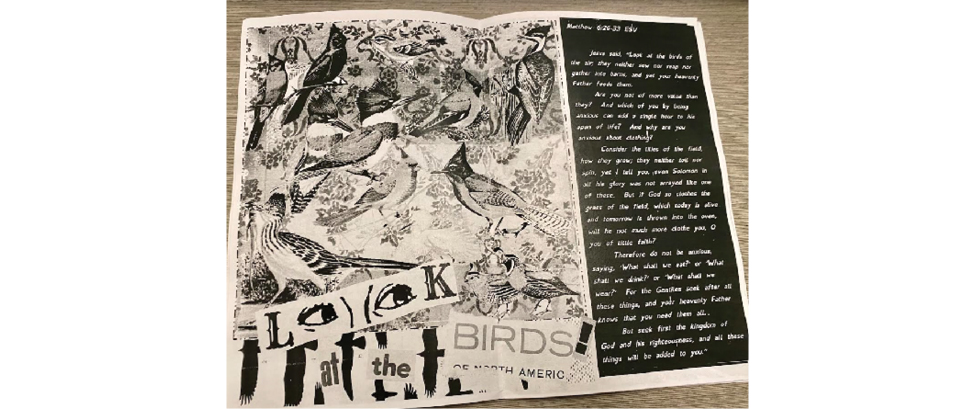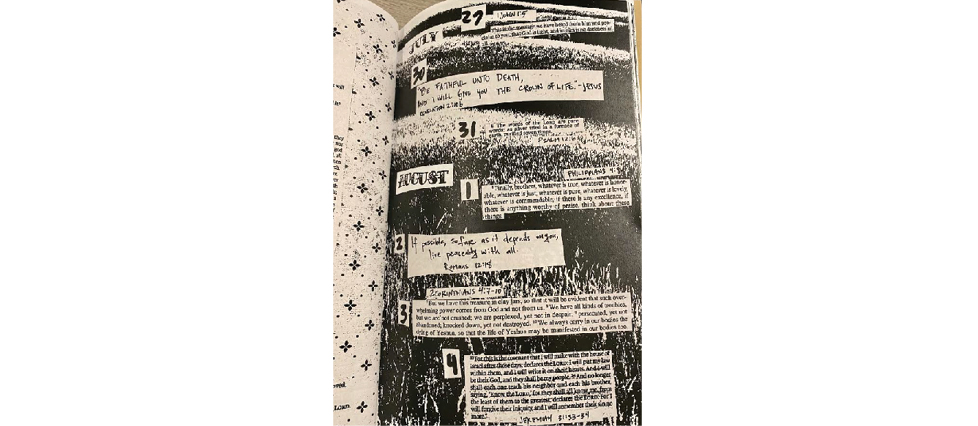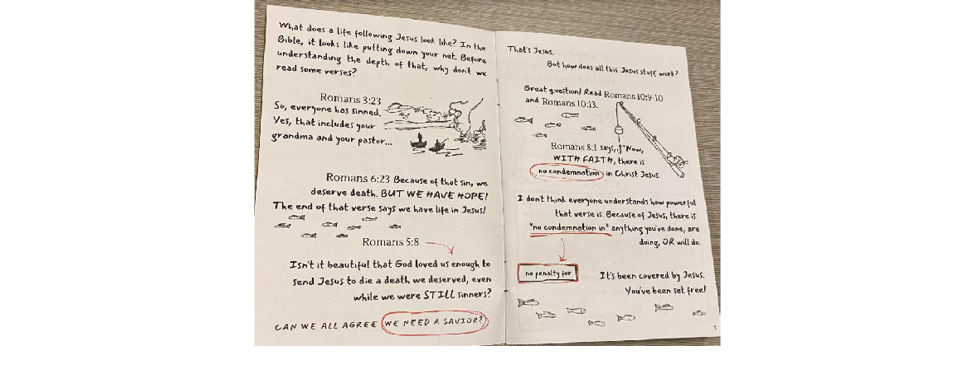Doing It Yourself
An Introduction to Zines
Abstract: Zine collections are rapidly becoming more common in academic and public libraries. The ephemeral nature of zines makes them excellent additions to a library’s special collections department and to researchers searching for a snapshot into a period of time in different subcultures, religions, and communities. This article explores the nature of and necessity for incorporating zines into your library’s collection by doing it yourself (DIY) without the assistance of professionals.
Zine Basics
Zines are self-published magazines created by individuals or small groups. Because they are self-published rather than published in the traditional sense, creators have complete control over the design of their zines. This autonomy allows zines to become true works of art that often serve as creative ways to relay information and educate others on certain topics. There are zines on nearly any topic one can imagine. Although some e-zines now exist in digital format, this introductory article focuses on print zines because zines have historically been distributed physically.
To understand zines, it is important to first understand the philosophy of DIY, which is key to the creation and overall independent spirit of zines. Subject matter varies from creator to creator. Some zines are made simply as a form of creative expression, whereas others are created with the intention of educating readers on a particular topic. Because they are not commercially designed, published, or printed, most zines have a limited print run, generally fewer than 1,000 copies (Wrekk 2020, 9). However, some zines have print runs of only 100 copies. Print runs of zines are typically created using photocopy machines (Wrekk 2020, 9). These machines allow creators to mix different mediums to make their unique and creative works. It is not uncommon to find handwritten text alongside appropriated text and images manually cut from various sources. Zines can be made in any size, ranging from miniature to full-size. The smallest zines have been created using only one sheet of paper (Wrekk 2020, 38), which is transformed into a multipage document by careful folding and cutting.
Pages are stapled together to create a document that can be read like any mainstream magazine found at a local newsstand. Zine creators usually distribute final copies themselves. Zines are found at concerts, zine fairs, online shops, and community events. They can also be purchased at independent bookstores, such as Quimby’s Bookstore in Chicago. Although zines are available for purchase, they are not usually created with generating a profit in mind. Instead, they are created for the purpose of sharing a story, spreading information, or displaying art.
Zines of the 1980s and 1990s
Zines, also occasionally referred to as “fanzines” or “pamphlets,” have been circulating in various subcultures for a number of years. My first introduction to them came when I learned about zines created by members of the punk rock and riot grrrl communities in the 1980s and 1990s. These zines typically addressed happenings in the punk rock and riotgrrrl music scenes. Readers of these zines could find album reviews and musician interviews within the pages. This information was invaluable to fans of underground music, as popular entertainment journalists largely ignored music from these subcultures. Imagine how exciting it would have been to go to a concert and find a zine featuring an interview with your favorite underground band. The riot grrrl community in particular added additional information to its zines, including women’s health information. Stumbling upon health facts featured alongside an album review could have been lifesaving for a woman who otherwise may not have had access to such information.
In the 1980s, a Christian punk rock scene emerged from the standard punk rock scene. Naturally, members of this community began to make, print, and distribute their own zines. These creators found that zines were the perfect way to share their faith and engage with other Christians. Zines became an intimate way to explore Christianity and the teachings of Jesus. However, these are not the only communities creating and printing zines. Zines have been distributed by many other communities and subcultures as a means of sharing information.
Zines in the Library
It is rapidly becoming more common for academic and public libraries to have zine collections. Some libraries’ faculties may be interested in collecting zines created by certain communities. The Metropolitan Library System in Oklahoma collects zines created by teenagers in the Oklahoma City area for its John Hilbert Zine Collection (Metropolitan Library System n.d.). Other libraries’ faculties are interested in collecting zines of all kinds. The Pace University Zine Library has materials covering a wide variety of topics, including houseplants, fashion design, and health insurance (Pace University n.d.). The ephemeral nature of zines makes them excellent additions to a library’s special collections department. Zines are valuable resources for researchers, providing direct snapshots into specific periods of time in various subcultures and communities from individuals who were active members.
In terms of cataloging, zines can be handled similarly to typical library materials. Some zines are monographs; others are serials. As with other library materials, cataloging treatment depends entirely on the item in hand. It is important to keep in mind that, due to their lack of widespread distribution and limited print runs, zines could prove challenging to catalog. In response to these cataloging challenges, the American Library Association (ALA) published Zines in Libraries: Selecting, Purchasing, and Processing (2019, ALA Editions) by Lauren DeVoe Sara Duff Core. A forthcoming title from Library Juice Press is Zine Cataloging: A Guide for Libraries and Independent Collections by Joshua Barton and Violet Fox.
Examples of Zines
Here I share four examples of zines I purchased directly from their creators’ online Etsy shops. The first featured zine, created by Patricia Free of Total Liberation Zines, is titled Grounded. In this third issue of the zine, Free discusses her experience with the Almeda Fire, which occurred in Southern Oregon in 2020. She uses her zine as a way to process the grief of the catastrophic fire through the power of God’s love.1 The zine showcases photographs Free took, as well as relevant quotes from scripture

Image 1: Interior spread of Grounded (Total Liberation Zines)
The second featured zine, also created by Patricia Free, is titled Reconciled! A Collection of Scriptures. The author handcrafted the zine, which is a daily devotional. Free was inspired to create this zine because she could not find a daily devotional that contained only scripture without commentary.2 This particular example shows the mixing of text styles frequently found in zines, including both print and handwritten text against a photo background.

Image 2: Interior page of Reconciled! A Collection of Scriptures (Total Liberation Zines)
The third featured zine, created by Chrissy J. Lewis of Even in the Valley Gifts, is titled Put Down Your Net: A Zine for New Believers. Lewis created this zine to have something on hand to offer new believers answers to common questions and an introduction to the foundations of the Bible.3 It is a smaller sized zine, allowing readers to easily carry it with them. The zine also features hand-drawn illustrations.

Image 3: Interior pages of Put Down Your Net (Even in the Valley Gifts)
The final featured example is a zine created by Sherilyn M. Cook and titled The Listening Lamb Zine. In her zine, Cook uses illustrations of and text about animals to show readers how they can see God in each of them.4 Animals are also used as examples for readers to learn various lessons from the Bible. The zine features Cook’s original artwork.

Image 4: Interior page of The Listening Lamb Zine
References
Cook, Sherilyn M. n.d. The Listening Lamb Zine, vol. 1, issue 1. Granbury, TX.
Free, Patricia. 2021. Grounded, no. 3: Winter 2021. Jacksonville, OR.
Free, Patricia. n.d. Reconciled! A Collection of Scriptures. Jacksonville, OR.
Lewis, Chrissy J. n.d. Put Down Your Net: A Zine for New Believers. Mobile, AL.
Metropolitan Library System. n.d. The John Hilbert Zine Collection. Accessed June 5, 2024. https://www.metrolibrary.org/john-hilbert-zine-collection.
Pace University. n.d. Pace University Zine Library. Accessed June 5, 2024. https://libguides.pace.edu/ZineLibrary.
Wrekk, Alex. 2020. Stolen Sharpie Revolution: A DIY Resource for Zines and Zine Culture. Portland: Lunchroom Publishing.